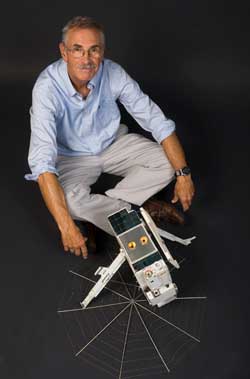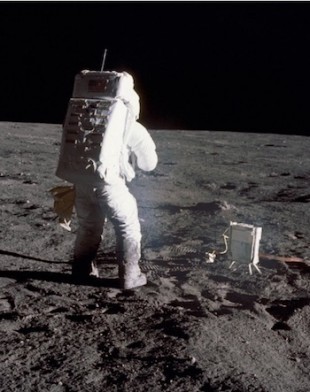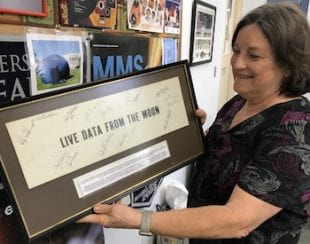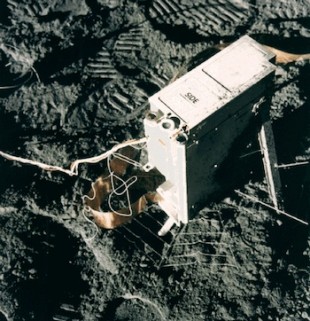2019 INTRODUCTION | PART 1 | PART 2 | PART 3 | PART 4 | PART 5 | PART 6 | LINKS
The Rice stuff: The moon as our laboratory
Apollo 11 accomplished Kennedy’s goal, but the mission did little in the way of science. Neil Armstrong and Buzz Aldrin’s moon walk was brief, and they left just two experiments on the lunar surface. One, the matchbox-size Dust Detector Experiment (DDE), was built at Rice.

John Freeman sits by a mechanical mock-up of the Suprathermal Ion Detector Experiment, or SIDE. Three copies of the Apollo-era experiment are on the moon. (Photo by Tommy LaVergne/Rice University)
When Apollo 11 landed, Rice’s Space Science Department was just 6 years old. But within months of the department’s founding, Rice had established the Satellite Techniques Laboratory, where instruments like the DDE could be designed, built and tested.
“With astronomy, the data you gather is all remote sensing from instruments on Earth or in Earth orbit,” said Patricia Reiff, professor of physics and astronomy and director of the Rice Space Institute. “With space physics, the fundamental difference is that we’re sending the instruments out into space to make local measurements — ‘space truth.’ In the case of Apollo, we were both investigating the moon itself and using the moon as a platform to study the Earth’s magnetic field, the ‘solar wind’ and other phenomena.”
The solar wind is high-energy radiation and particles from the sun that are blown through the solar system at more than a million miles an hour. Today, scientists know the solar wind causes the aurora borealis and space storms that can knock out satellites and even terrestrial power grids, but the existence of the solar wind had only been confirmed by satellite-based instruments in 1959.
From its inception, Rice’s space science program was a leader in studying the solar wind and its interactions with Earth’s magnetic field, which shields life on the planet from lethal doses of radiation that ride the solar wind. (Curt Michel, Rice’s Andrew Hays Buchanan Professor Emeritus of
Astrophysics and a former astronaut, carried on his studies of the solar wind when he went to NASA.)
When Apollo 12 landed on the moon in November 1969, it carried the first Apollo Lunar Surface Experiments Package (ALSEP), a set of experiments powered by a small, 70-watt nuclear power station. ALSEP was configured differently on each mission, but of the seven experiments chosen by NASA for ALSEP in 1966, two were built at Rice and designed to measure particles from the solar wind.

Apollo 12 astronaut Alan Bean with Rice’s SIDE experiment at the Ocean of Storms, November 1969.
One of these, the Suprathermal Ion Detector Experiment (SIDE), was built in the lab of John Freeman, who’d arrived at Rice in 1964 from the University of Iowa, where he earned his Ph.D. in the lab of space science pioneer James Van Allen. SIDE was designed to measure the moon’s exosphere, a thin cloud of gases near the lunar surface that is constantly ionized by the sun’s ultraviolet light.
“The lunar exosphere is very tenuous because there’s not much gas up there,” said Freeman, now a professor emeritus of space physics and astronomy at Rice. “SIDE could measure the constituent gases of this. It was mostly hydrogen, some helium and neon.”
But getting the experiments ready to fly was a monumental task, partly because the science was new but mostly because of Apollo’s decadal deadline.
“The Apollo program had such incredible time pressures on it,” Freeman said. “We were building hardware and hiring subcontractors before we actually had the paper contracts. This was the story of NASA throughout.”
SIDE was built by subcontractors in California and tested at Rice in a series of vacuum chambers, ion beams and vibration tables set up in the basement of the Space Science Building.
“That’s where we worked day and night, 24 hours a day, getting this thing tested and calibrated and ready for flight,” Freeman said. “It was so rough that I actually ended up in the hospital with a near-nervous breakdown.”

Patricia Reiff displays a sign that hung above the NASA control room where scientists monitored lunar experiments. The sign is autographed by those present when the experiments were shut down in September 1977.
In the end, the work paid huge dividends. SIDE flew on Apollo 12, 14 and 15, returning data from each site for about two years. The experiment was the first to detect water vapor on the moon, and it made a series of groundbreaking findings about the composition and nature of the Earth’s magnetosphere.
Reiff, then a newly arrived graduate student at Rice, got a job in early 1971 writing computer programs to analyze data being returned from the moon by Rice’s third lunar experiment the Charged Particle Lunar Environment experiment (CPLEE; pronounced SEE-plee), which had landed with Apollo 14 weeks earlier.
“I got to be at Mission Control when all of the later flights landed, and even more importantly, when they took off from the moon,” Reiff said. “I’ll never forget the cheer that went up, especially after they got the remote cameras on the rover and you could see the capsule blasting away from the moon.”
CPLEE was designed and built in the lab of space scientist Brian O’Brien, who’d also designed the DDE. O’Brien left Rice before the first lunar landing, but one of his first graduate students, David Reasoner, joined Rice’s faculty and continued the project and was Reiff’s Ph.D. thesis adviser.

The SIDE experiment deployed by Apollo 14 astronauts Alan Shepard and Edgar Mitchell at the Fra Mauro highlands, February 1971.
Like SIDE, CPLEE was designed to measure charged particles at the lunar surface. CPLEE’s specialty was measuring plasma-energy electrons, and scientists working in the ALSEP control room at NASA could remotely reconfigure the instrument and watch the data in real time. This allowed them to view the fluxes and flows of the solar wind as it blew past Earth’s magnetic field.
CPLEE returned a raft of data, including the first measurements of electrons from the lunar surface and several other groundbreaking discoveries about the solar wind and magnetosphere. In August 1972, just a few months before Apollo 17 landed, CPLEE was bombarded by intense radiation from a solar flare that would have killed any astronauts who might have been orbiting or walking on the moon at the time. Reiff wrote her first scientific paper about the event and continued to analyze data from the experiment until September 1977, when NASA decided to shut down all the ALSEP experiments, due to budget cuts.
Reiff and Freeman attended the funereal ceremony in the ALSEP control room the day the experiments were turned off, and Reiff wound up throwing the switch that extinguished the last Apollo instrument returning data from the moon. She later told a TV crew covering the event, “It felt like pulling the plug on my grandmother.”
Though it was the end of the Apollo era, it was not the end of NASA and Rice’s connection or of Rice’s quest for space discoveries.




Leave a Reply